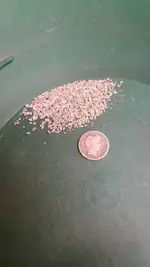California Collusion;
The Big Lie
.
Research | dredge study's;
Mining Research
Exactly

But...
This is OLD news for those that have had their heads buried in the sand for the last 20+ years and if you haven't seen it before, or you haven't seen or heard about the cabins being burned or the families being displaced in California for the last 100 years, listed in many places and newspapers many many times and even in this century, then please, just place your head back where it belongs - deep, deep, deep in the sand!
As quoted from the WMA of which many of us have been members since their beginning
""First get your facts straight, then you can distort them as you please." Mark Twain
Environmentalists know if you push a lie long enough, and hard enough, people will believe it's the truth. We expect this from them. When the government assists them in this lie, at the expense of decent, hardworking people, it's unconscionable.
Suction dredging is controversial but does it harm fish or the environment in any appreciable way? In 1960 the California legislature passed the first law which required regulation and permitting of the use of suction dredges, for the protection of salmon spawning areas.
Canyon
Above. Little dredge, big canyon, big lies to ban it.
From 1961 to 1994 suction dredging went on largely unnoticed. In 1994 the first full Environmental Impact Report (EIR) was conducted by the California Department of Fish and Wildlife (CDFW) and concluded suction dredging, under reasonable regulation, would cause no significant harm to the environment.
This should have been the last word, right?
The California Environmental Quality Act, passed in 1970, allows only 30 days for opponents of a project to challenge a completed EIR. In 1994 no one challenged the EIR meaning it was final. The Act also exempts any activity which was ongoing, and required a permit, prior to the passage of the law which meant suction dredging was exempt.
Kind of. CEQA also allows an EIR to be re-opened under a very limited set of circumstances which includes new information is presented which was unknown, and could not have been known at the time of the EIR. Those conditions are very well defined, and also very restrictive. They are meant to keep the government from conducting repeated EIRs each time someone finds some other minor issue with the project, which environmentalists always do.
Almost immediately the environmental groups realized they had missed their opportunity to challenge the EIR and kill suction dredging, but there was no legal way for them to stop it.
The environmental groups began putting pressure on CDFW to conduct a new EIR, one which would find significant effects were in fact occurring and to shut down suction dredging throughout the State.
In 1995 CDFW began the preliminary work to prepare a new EIR, one which they believed would pacify the environmentalists, at the expense of legal mining claim holders. This 1995 effort was killed when miner John Oates obtained a letter from the US Forest Service Oates had asked the US Forest Service minerals examiner why California was immediately conducting another EIR when one had been completed less than a year before.
The USFS minerals officer, Richard Zambiac, called CDFW and spoke to their senior fisheries biologist, Mr. Steven Taylor. The response received isn't surprising, but it is instructive, Mr. Zambiac replied to Oates with the following:
"...he stated he did not know very much about mining, but he knew a lot about writing regulations...Mr. Taylor stated that the reason for the proposed Regulations was because the Department of Fish and Game is getting a lot of pressure from influential special interest groups that don't believe miners should be working in the rivers.' He then went on to say the proposed regulations would be a good starting point to get this situation under control even though the Department had little scientific evidence that dredging in the rivers really has a long term negative impact on fish and other aquatic life."
Save The Salmon
In 2003, responding to complaints from the Karuks the Department sent two fisheries biologists, Mr. Dennis Maria, and Mr. Bob McCallister to the Salmon River to investigate the effects of suction dredging. They went to the river on the last day of dredging season, which meant all effects from a season of dredging were observed. Their report concluded:
"The dredge holes created the only discernable juvenile rearing habitat (rearing & escape cover) that I could see...This rearing habitat consisted of "clean" unimbedded cobbles that covered the dredger pool substrate."
"...the relatively light accumulation of fines observed at this location, the general lack of rearing habitat (cover) in this reach and the relatively high temperatures found here...makes it unlikely that the current dredging impacts will significantly or substantially harm anadromous salmonid spawning..."
"In fact, for an area which had been dredged all summer long, I saw relatively innocuous disturbance to the existing habitat."
"In summary...I saw nothing that would be considered a violation or that would have a significant impact to the fishery or significantly negatively impact the overall biotic community of the Salmon River."
In 2005 the Karuk tribe filed a lawsuit in Alameda County claiming because the coho salmon were now classified as a threatened species and demanded the Department close the Scott, Salmon and Klamath Rivers to suction dredging.
This lawsuit, while claiming dredging "may" harm salmon, with no proof, didn't mention the killing of over 75,000 salmon per year by the Indian Tribes on the Klamath River."
Once again... Fishermen are responsible for killing the fish... Duhhhh....










 Since my boots are on "my" particular creek I'll use it as an example. By the time summer arrives there can be as much as 6 to 10 feet of overburden on the bedrock base of this creek but just one heavy storm:
Since my boots are on "my" particular creek I'll use it as an example. By the time summer arrives there can be as much as 6 to 10 feet of overburden on the bedrock base of this creek but just one heavy storm: